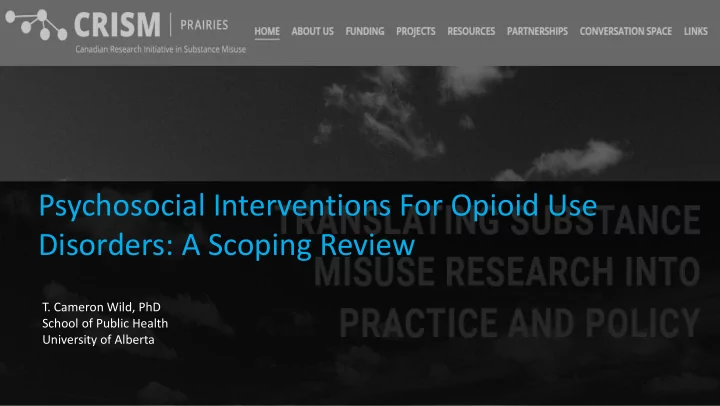

Psychosocial Interventions For Opioid Use Disorders: A Scoping Review T. Cameron Wild, PhD School of Public Health University of Alberta
Disclosure • Funding for this project was provided to CRISM | Prairies by Health Canada, via the Canadian Institutes of Health Research • I have no actual or potential conflicts of interest to declare in relation to this presentation
Background • “ The most that any chemical agent can do for an addict is to relieve his compulsive drive for illicit narcotic…Methadone and other medications can be produced in large quantity, but the compassion and skillful counseling needed for rehabilitation of addicts are not replicated in the climate of bureaucracy” (Dole & Nyswander, 1976, p. 2119). • More than 40 years after Dole and Nyswander’s assessment of their seminal work documenting the effectiveness of methadone maintenance and their endorsement of “skillful counseling” and other non -pharmacologic interventions as essential components of OAT, the role of psychosocial interventions in the treatment of opioid use disorders (OUD) is equivocal.
Background • A 2011 Cochrane review of 35 RCTs ( N = 4319 patients) found that in comparison to OAT with standard medical management alone, adding structured psychosocial treatment interventions to OAT did not improve patient adherence, retention, or abstinence from opioid use during or after treatment (Amato et al., 2011). • Trials published subsequent to Amato et al.’s review have yielded mixed results. • This evidence problematizes Dole and Nyswander’s views on the role of psychosocial interventions in OAT. Nonetheless, clinical practice guidelines for OUD around the world state that structured psychosocial interventions should be regarded as essential components of treatment for OUD.
Rationale (1) • Extant evidence focuses on whether adding psychosocial interventions to pharmacotherapy enhances patient outcomes compared to pharmacotherapy alone. • How often have different research questions (e.g., efficacy of stand-alone psychosocial treatments, or stand-alone psychosocial interventions versus pharmacotherapies) have been addressed? • Trial evidence is central for informing clinical practice, but generalizability to routine treatment services and heterogeneous patient populations may be compromised due to strict inclusion and exclusion criteria into RCTs (e.g., heroin users only). • Is evidence from other study designs (e.g., quasi-experiments; prospective cohorts; qualitative methods) informative? Cochrane-style reviews exclude those evidence sources.
Rationale (2) • Many psychosocial interventions are provided in OUD treatment. • How much heterogeneity ? What are the most commonly studied approaches? • Extant evidence prioritizes retention in treatment and substance use as primary outcomes. • Has evidence been produced on other outcomes viewed as important for rehabilitative treatment goals (lifestyle changes, quality of life, income and other social determinants of health)?
Objectives Identify all empirical studies and reviews that have investigated psychosocial 1. interventions used in the treatment of OUD, with or without pharmacotherapies. Describe the range of evidence sources available in the scientific literature in 2. relation to study populations , types of treatments , research questions , outcome measures.
Methods Search strategy developed iteratively with the assistance of a professional research librarian. Multiple test searches were conducted using an a priori list of keywords and subject headings to develop and refine database-specific controlled vocabularies. These were used to search five databases for eligible studies, including Ovid MEDLINE, EMBASE, CINAHL, Cochrane Library, and PsycINFO. English-language articles published up to July 2017 were eligible for inclusion in the review Included articles coded as applicable on 122 variables grouped into 6 domains: publication characteristics, evidence sources, research designs used in comparative studies or evaluated in articles reviewing comparative studies, study populations, treatment modalities, type of intervention(s) offered to patients, and outcomes assessed.
Overview of search and screening 40,772 records identified through database searching 17,522 duplicates removed 23,250 records screened 19,859 records excluded 3,391 full-text articles assessed for eligibility 64 identified through hand searches 80 Unable to retrieve full text 2,965 full-text articles excluded Total number of articles included: 410 Total number of studies included: 412
Inclusion and exclusion criteria Articles included if they Articles excluded if they Investigated or reviewed treatment of co-morbid medical conditions unrelated to OUD (e.g., diabetes, Reported results of research on human samples or populations seeking treatment for OUD , and obesity, cancer, pain, etc.), and/or Investigated or reviewed research on the impact of pharmacologic or psychosocial interventions on Reviewed or reported empirical (quantitative and/or qualitative) results of primary studies investigating neonates with OUD (research on treatment of the mother prior to the delivery was potentially eligible structured non-pharmacologic interventions ** in the treatment of OUD, with or without the use of for inclusion), and/or pharmacologic treatments (e.g., methadone and/or buprenorphine), and/or Investigated psychosocial treatment or prevention of comorbid conditions that influence outcomes of Investigated or reviewed research on the use of opioids in pain management only, and/or OUD treatment (e.g., non-pharmacologic interventions to address mental disorders or physical conditions directly related to OUD, such as HIV, Hepatitis), and/or Investigated or reviewed empirical (quantitative and/or qualitative) results of research on housing, Investigated or reviewed research on biomedical aspects or correlates of OUD treatment (e.g., brain employment, or other interventions targeting social determinants of health in the context of OUD imaging), including pharmacokinetic studies (drug interactions, dosage testing), or reported only on treatment, and/or physiologic, biomedical variables, and/or Reported quantitative and/or qualitative results of research investigating treatment of symptoms of Reported clinical practice guidelines or local (grey literature) program evaluations, and/or OUD in any way, including with pharmacotherapies (e.g., clonidine to treat hypertension in withdrawal, etc.), and Investigated or reviewed OUD outside the context of treatment, and/or Investigated or reviewed research on measurement/assessment tool validation, and/or Provided commentary, responses, editorials, letters to the editor, or were dissertations, and/or Were English-language articles published by July 2017 Reported conference abstracts, conference proceedings, and/or Reported study protocols only, and/or Were not published in the English language, and/or Investigated or reviewed research on OUD in non-human species
Recommend
More recommend